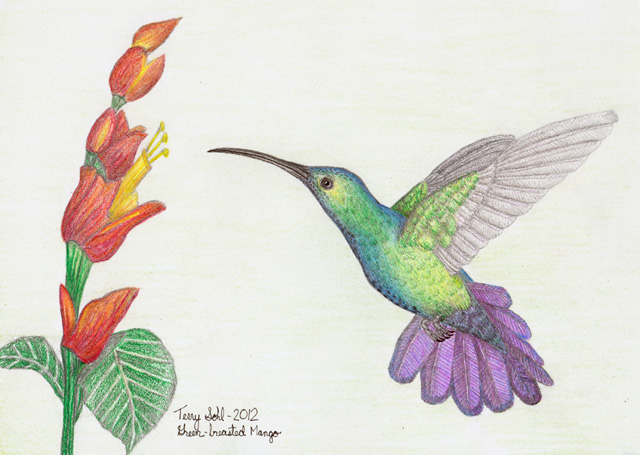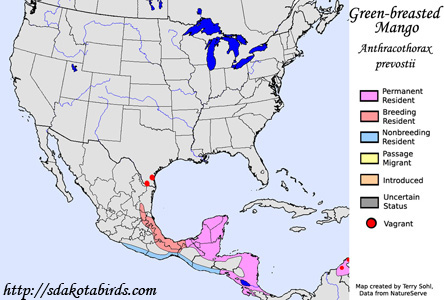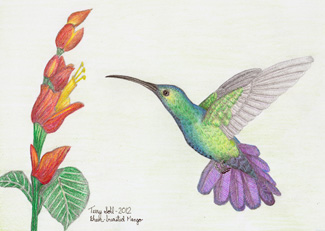Green-breasted Mango
Anthracothorax prevostii
| Length: 4.5 inches | Wingspan: 6.25 inches | Seasonality: Non-resident in South Dakota |
| ID Keys: Green plumage on upperparts, brilliant green underparts on male, female has light underparts with obvious dark stripe | ||
 The
Green-breasted Mango is a hummingbird of tropical America. They are
normally found near the coasts of central and southern Mexico, and in
Central America, but populations also occur in a few locations in northern
South America. They were unknown in the United States until a bird was
identified in south Texas in 1988. While still a very rare vagrant in
the United States, they have been found a number of times since, mostly in
south Texas and a few in Florida, but also with single sightings in North
Carolina, Wisconsin, and Georgia. A female Green-breasted Mango, has
an obvious central stripe on light-colored underparts. Males (depicted
in the drawing on the right) have a brilliant green plumage on their underparts.
The
Green-breasted Mango is a hummingbird of tropical America. They are
normally found near the coasts of central and southern Mexico, and in
Central America, but populations also occur in a few locations in northern
South America. They were unknown in the United States until a bird was
identified in south Texas in 1988. While still a very rare vagrant in
the United States, they have been found a number of times since, mostly in
south Texas and a few in Florida, but also with single sightings in North
Carolina, Wisconsin, and Georgia. A female Green-breasted Mango, has
an obvious central stripe on light-colored underparts. Males (depicted
in the drawing on the right) have a brilliant green plumage on their underparts.
Habitat: Green-breasted Mangos are primarily found in open woodlands and savannahs, as well as around tropical deciduous forests, typically at lower elevations up to around 3,000 feet. They also have adapted to vegetated suburban habitats.
Diet: Typical diet of hummingbirds, primarily nectar, but insects also comprise a portion of the diet.
Behavior: Males establish feeding territories and aggressively defend them against other hummingbirds.
Nesting: Males form loose breeding groups, displaying to passing females through high display flights. Females build the nest mostly from plant fibers, and camoflague the outside with bits of moss. The female also incubates the eggs and raises the young.
Song: Males sing a buzzing song during courting. They also have a high-pitched "tsip" call.
Migration: Permanent populations are present in most of the eastern portion of its range, particularly in Central America and around the Yucatan peninsula. Birds that summer on the central Mexico Gulf coast are migratory, moving eastward for the winter, or south to the Pacific coast.
Interactive eBird Map: Click here to access an interactive eBird map of Green-breasted Mango sightings
Feeders: Will attend hummingbird feeders
Similar Species: Similar to other Mango species, particularly the Veraguan Mango and the Black-throated Mango. However, those species have not been seen in the ABA North America region.
Conservation Status: No conservation concerns are presently noted for the species
Further Information: 1) Cornell's Neotropical Birds - Green-breasted Mango
2) WhatBird - Green-breasted Mango
3) AvianWeb - Green-breasted Mango
Image Information: Colored pencil drawing by Terry Sohl - 2012
| Click below for a higher-resolution map |
 |
| South Dakota Status: Non-resident in South Dakota |
Additional Green-breasted Mango Images
Click for a higher-resolution version of these photos

